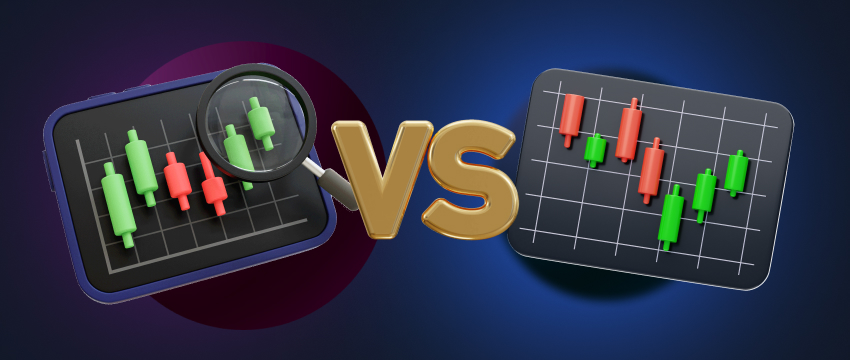A day trader profits from small price changes. They buy and sell shares quickly throughout the day. Their objective is to generate revenue from rapid price shifts. Most day traders use forex leverage. It can boost profits but also increases the risk of bigger losses.
Imbalances in goods and services are unique in nature as they help buyers, sellers, and traders make smarter decisions. This means capturing quick price moves. Traders hold positions for seconds or minutes. They rarely keep stocks for hours.

How day traders work
There are no formal qualifications needed to become a day trader. Instead, day traders are identified by how often they trade.
How is a day trader defined?
According to the Financial Industry Regulatory Authority (FINRA) and U.S. The Securities and Exchange Commission defines a short-term investor as someone who makes 4 or more trades within five days.
These transactions must account for more than 6% of total activity, or the forex broker may label them as short-term investors.
Closing positions daily
A day trader typically closes all trades before the end of the trading day. They do this to avoid the risks associated with holding positions overnight.
Costs and tools matter
Factors like the bid-ask spread, trading commissions, 그리고 fees for real-time news 택하고 analytical tools can affect their results.
Knowledge and strategy are key
To succeed, day traders need strong knowledge, experience and skills. Day traders use different methods to decide when to invest, some rely on 기술적 분석 and computer models to assess probabilities, while others trust their instincts.
Focus on Price Action
A day trader’s primary focus is a stock’s price action dynamics. Unlike traders, investors focus on a company’s long-term growth prospects, relying on fundamental information.
Only after this analysis do they determine whether to buy, sell, or hold the stock.
Volatility and Liquidity are essential
Price volatility and average day range are necessary for a day trader. The price movement of a security must be large enough for a day trader to generate revenue.
Traders achieve small returns per trade by quickly entering and exiting positions, so they also need high volume 택하고 liquidity.
A day investor would not be concerned with securities that have low daily range or low daily volume.
Things to know about day trading
Day trading focuses on factors that influence market movements within a single day, unlike position trading, which looks at longer-term trends. Before starting to day trade forex, keep these factors in mind:
Liquidity:
This refers to how quickly you can enter or exit a trade. High liquidity is crucial for day traders who often make multiple trades each day.
Volatility:
The rate at which an asset’s price fluctuates. High volatility can offer opportunities for short-term profits, but also carries more risk.
Trading Volume:
This measures how many times an asset is bought or sold within a specific timeframe.
High volume indicates strong market interest and helps identify potential entry and exit points.
7 day trading strategies
There are various strategies you can use for day trading, such as trend trading, swing trading, scalping, mean reversion, and money flows.
추세 트레이딩
The aim of trend traders is to potentially profit from studying the direction of an asset’s price and making proper transactions based on these movements.
Traders sell when prices decline, and they buy when prices rise. Day traders do not carry out trend trading alone, but intra-day traders close their positions at the end of the day.
Swing trading
Short-term trend price movements are exploited by swing traders. Instead of concentrating on the longer-term trends, these traders concentrate on the shorter reversals or price movements.
They can potentially generate revenue faster from both increasing and decreasing prices by speculating on these movements.
Scalping
Aiming at making various small gains during the day, scalping is a quick and short-term investing approach.
Instead of making a few large transactions, the forex strategy aims to gradually grow the account size over time through numerous small gains.
Scalpers close out positions at the end of the day to avoid overnight fees and require strict exit strategies to avoid losses.
Mean reversion
The theory on which this approach lies is that eventually, prices would revert to their long-run mean.
Traders use technical indicators like moving averages to identify assets whose current price deviates significantly from their historical average, in the hope that the price will revert to the mean.
Money flows
The money flow indicator determines whether an asset is overbought or oversold using its price and volume.
A reading below 20 suggests the asset is oversold (a time to buy), while a reading above 80 suggests the asset is overbought (a time to sell).
News-based strategy
This approach aims to take advantage of the extra volatility surrounding headlines and news events, seeking to profit from such market activity.
High-frequency strategy
This strategy makes thousands of transactions per day by taking advantage of millisecond or short-run market inefficiencies using advanced computer algorithms.

To day trade or not?
No overnight risk
One of the most important advantages of day trading is that positions are not vulnerable to potentially adverse news that could have a profound impact on securities prices overnight.
This encompasses broker downgrades and upgrades that can take place outside of market hours, along with major economic 택하고 earnings reports.
Faster exits & high leverage
The availability of tight stop-loss orders, which help close long positions and limit losses, is advantageous to day traders.
Additionally, margin access, which gives them more leverage, is more accessible to them.
Short-term investing tends to also offer the possibility to learn new skills and further develop current ones.
Increased costs
There can be insufficient time for intraday traders to let a position gain a profit.
Additionally, the greater commission paid as a result of day trading’s requirement for more frequent trading can lower overall returns.
Higher risks
Short sellers and margin-enhanced day traders could risk experiencing a severe spike in their losses that could initiate margin calls.
How to start day trading
Select your trading approach
You can speculate on price movements without owning the underlying asset via CFDs.
Develop a trading strategy
Carefully define your goals, risk tolerance, 그리고 strategy. Guide your trades using technical or fundamental analysis.
Learn more about risk management
In order to potentially reduce losses, use tools such as stop-losses.
Open & monitor your position
To avoid overnight charges, open the initial trade, keep informed regarding market trends, and close the positions by end of day. To improve over a period of time, keep an eye on your trades.

Final thought
Day trading involves entering and exiting one or more transactions within the same trading day, before the market closes. It’s commonly applied to forex and indices due to their high liquidity and spreads.
Day traders aim to capitalise on very short-term price fluctuations in the stock or forex markets, seeking to generate revenue throughout the day.
While this approach can be rewarding, it also carries significant risk, particularly when forex trading with leverage.
Success in day trading requires not only a strong grasp of the markets but also discipline and the ability to avoid impulsive decisions.
Disclaimer: This material is for general informational and educational purposes only and should not be considered investment advice or an investment recommendation. T4Trade is not responsible for any data provided by third parties referenced or hyperlinked in this communication.




